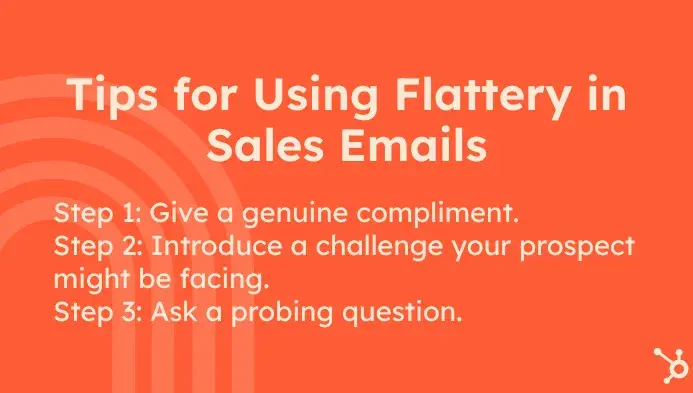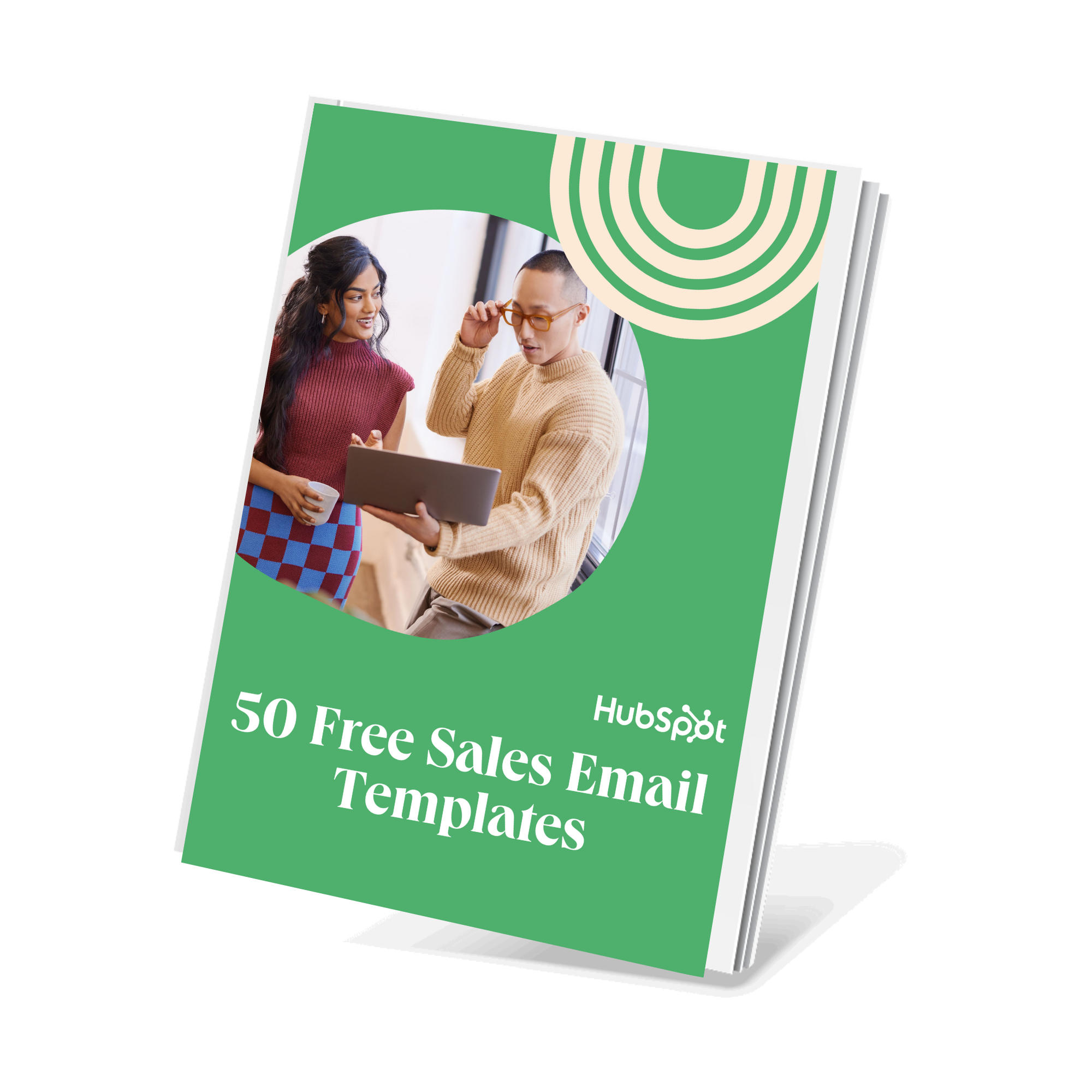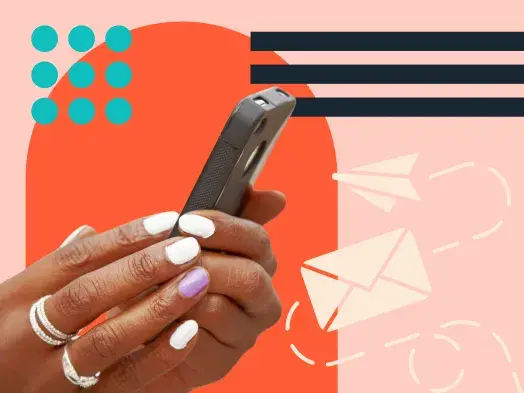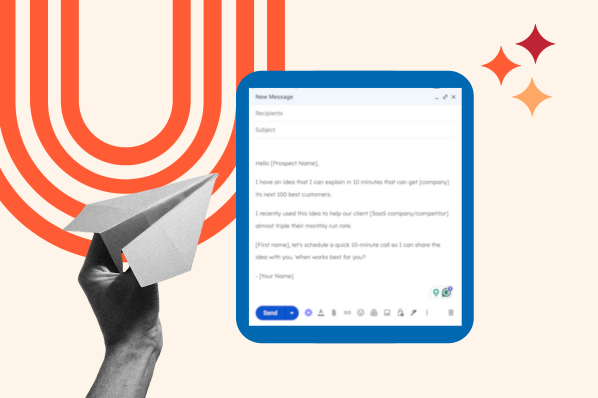Table of Contents
- How I Tested Out Flattery in Sales
- Using Flattery in Sales: 12 Templates to Try
- How Our Flattery Sales Templates Performed
- Tips for Using Flattery in Sales Emails
How I Tested Out Flattery in Sales
I recently had the opportunity to help a sales team transform their old prospecting templates. As an advisory board member for an influencer marketing platform, I helped the sales team improve its sales processes.
Using HubSpot Sales Hub, I could see they were getting a high open rate with their current templates, but response rates were not where they should be. So, I collaborated on a few new email templates they could test.
In a short amount of time, we‘ve increased their response rates considerably. I’ve included several of the templates below.
But before I dig into the new email templates, let’s talk about the old ones. The major issue is that they were all about them. While the information was all true (the platform is awesome and it does drive real results for brands), prospects weren't replying.
The team observed that response rates rose when they customized the templates by referencing something the prospect was doing. So, it wasn't difficult to convince the reps to start doing more research for each prospect, as well as test some new approaches that talked more about their prospect and less about the seller.
Working with one of the company’s top performers, I brainstormed a few new ways to reach out. The revamped email templates below are getting much higher response rates, not to mention much more enthusiastic replies.
Using Flattery in Sales: 12 Templates to Try
Email Template #1: “Love your videos”
The company’s reps are always asking their friends and contacts which products they use and why, because this helps them identify opportunities to pursue. Whenever they can, they also sign up for anything the brand offers like a beta notification about a new service, or a blog, newsletter, YouTube or Instagram feed.
This prospecting email template makes it clear how much research the rep has done.
Subject line: Referred by a friend. Love your YouTube videos
Hi [Prospect],
A friend of mine just introduced me to [Brand]. He had such high praise that I immediately signed up for your [product] beta launch notification.
He also told me that I‘d be impressed with your influencer marketing. He was right! Looks like you’re getting some great traction with the [hashtag] Instagram posts and I really loved this YouTube video: [link]. Great choice to work with [YouTube creator] as they always seem to drive great results.
Are you seeing a measurably higher customer acquisition rate from these [hashtag] posts and YouTube videos compared to other marketing efforts?
Best,
[Rep]
Why I Think It Worked
Part of the platform’s value proposition is that brands can track conversion by creator and campaign. Their team can also use historical conversion data to help brands pick creators for future campaigns.
So, this is clearly a great opening for a follow-up call or email where the rep can ask, “Would you like to find more creators who have proven they can drive conversions for brands like yours?”
In this way, this email template kickstarted a valuable conversation that will likely lead to a sale.
Email Template #2: “Featuring you”
Here‘s another template we’ve been testing.
Subject line: Your influencer marketing is excellent. Featuring it…
Hi [Prospect],
I‘ve been really impressed with your influencer marketing on Instagram and YouTube. I shared your YouTube video with my friends on Facebook and reposted a photo from [creator] on Grapevine’s Instagram page as an example of great influencer marketing. I felt she really brought your brand aesthetic into her amazing photo. You can see yours and other great examples of influencer marketing at #GrapeFinds: https://www.instagram.com/explore/tags/grapefinds/
I can see you‘re getting great buzz based on the number of likes. Are you happy with the increased engagement you’re getting compared to the spend?
Best,
[Rep]
Why I Think It Worked
This template only required about two minutes of effort from the salesperson. This also ended with a question, which is great for starting a dialogue. The prospect ended up responding and saying they were unhappy with their current vendor, a competitor. Jackpot!
Email Template #3: “A huge fan”
Here‘s a third template we’re testing.
Subject line: Popular YouTube creator [name] loves your [product]
Hi [Name],
I was speaking with [creator] the other day and she said that she‘s basically lived in your [product] all winter. She’s a huge fan of [Brand] She specifically loves X about [product].
I'm also a huge social media nerd and love your Instagram page. It looks like there are a number of influencers with strong followings who are sharing your products.
With this kind of success, campaign coordination via email and social channels usually becomes frustrating and time-consuming. Sometimes, it becomes almost impossible to track who you are working with, let alone the results from each campaign. How are you keeping yourself organized?
Best,
[Rep]
Why I Think It Worked
The prospect responded to the rep, thanking them for the enthusiastic product response. In this case, the challenge of manually managing so many influencers hit a nerve with this prospect. After realizing her company had the challenge mentioned in the email, the prospect did some quick research and realized they might be able to help.
Email Template #4: “Still interested in improving?”
We also devised a follow-up email template to send if one of these three first emails didn't elicit a response. The rep forwards the original note along with the note below when they follow up.
Subject line: My previous email about your influencer marketing success
Hi [Prospect],
Not sure if you saw my note below? Reason I‘m asking whether the campaign has been successful is because I’m always looking for ways to help my clients do better campaigns. Yours looks like a good example.
Would you like to swap notes or ideas re: influencer marketing? I have 100s of examples that I can share too.
Best,
[Rep]
[Original message]
Why I Think It Worked
This message accomplishes a few things. First, it puts the original message at the top of the inbox in case the prospect missed it or forgot to respond. Second, it tells them that the brand is an advocate for their clients, always trying to share best practices. Third, it sets the tone that the rep is an expert resource — more of a peer sharing best practices than a salesperson pitching a platform.
In this case, the prospect responded to say that their digital marketing budgets were already committed for the year, but that they would like to follow up with the rep the following year. As we all know, any response is better than none.
Email Template #5: “You’re killing the competition”
There’s nothing companies love more than a peek behind the curtain of their competition.
Subject line: Here’s how you compare against the competition
Hi [Prospect],
As I was reviewing your competitors in [industry], I noticed you’re outshining them in your social content. I loved the post where you [city specific post].
I’m happy to hop on a call and share your analytics compared to your two closest competitors. Would you be interested?
I also think you could expand your reach with influencer collaborations, and would be happy to demonstrate how [COMPANY] can help you do that.
Are you available for a call in the next few days to take a look at the competition?
Best,
[Rep]
Why I Think It Worked
Getting your hands on a competitive analysis is a mighty temptation. In this case, the sales rep offered to share competitive data from their platform. Of course, they got to showcase the power of the product and connect with the prospect in the meantime.
Email Template #6: “Heard great things about you”
A mutual-based introduction is always a win, and a sure way to turn a cold intro into a warm one. But this spin on the mutual contact intro leads with a compliment from your mutual contact.
Subject line: [Name] had great things to say about you
Hi [Prospect],
I was talking with our mutual connection, [common contact name], and they had great things to say about you [cite specific compliment]. They mentioned you’re looking for ways to improve [specific problem], and I’d love to help you brainstorm some solutions.
Would you be interested in discussing this more in a virtual coffee chat?
Looking forward to seeing how [company] can help with your problem.
Best,
[Rep]
Why I Think It Worked
First, the subject line piqued the reader’s interest, and a familiar name should all but guarantee an open. The mutual connection and flattery brought down the prospect’s guard and then segued to talking about solutions helped to book a meeting.
Email Template #7: “Great talk”
If you’ve heard a prospect speak on a panel, event, or even a webinar, that’s a great opener to start a dialogue.
Subject line: Great talk at the [event name]
Hi [Name],
I saw you speaking this past week at [event name] about [topic]. I loved your comments about [specific talking points].
I work with a lot of companies on [solution]. I believe I can help you with [problem], and would love to chat more about how we’ve helped others in your industry solve this problem.
If you have time, I’d love to set up a virtual coffee chat to discuss this further.
Best,
[Rep]
Why I Think It Worked
This message showed that I showed up or listened, I paid attention, and I have something intelligent to add to the conversation. It’s a personalized message that’s respectful and complimentary.
Warning: Only use this method if you actually listened to their talk, not if you simply copy/pasted the title of the talk.
Email Template #8: “Loved your post/article/newsletter”
If your prospect shares regular social content or has a newsletter, you should absolutely subscribe and follow it. Similar to the event flattery email, you can craft an email complimenting a social media post, a newsletter, or a guest article the prospect wrote to start a conversation.
Subject line: Loved your [post/article/newsletter]
Hi [Prospect],
I read and enjoyed your recent [post/article/newsletter] on [industry problem]. I appreciated your nuanced take on this complex issue. I talk with a lot of professionals facing this problem, and some of the solutions I’ve found include [list solutions].
Would you like to swap notes or ideas re: [challenge]? I have plenty of examples that I can share.
Best,
[Rep]
Why I Think It Worked
Again, this message starts with personalization and aims to start a dialogue, not just a sales pitch.
Email Template #9: “Congrats!”
If your client has had a recent win or news coverage, that’s a perfect excuse for some flattery. Whether your client won an award — or the prospect themself — it’s not hard to find a reason to celebrate.
Subject line: Congrats on your [recent win]!
Hi [Prospect],
I saw that [company] won the [award name] last week and wanted to say congratulations! No company deserves it more.
I’m curious what’s next on the horizon for your company? I’d love to hear what your goals are for next year and see if we can help you reach them through [company service].
Best,
[Rep]
Why I Think It Worked
Chances are, your prospect is excited about this win, giving you a good opening to take advantage of that momentum and help them think about continuing to scale and grow in the future.
Email Template #10: “Love your community”
If you’re worried direct flattery may come off as inauthentic, here’s an approach you can try: complimenting their customers.
Subject line: Your community is incredible
Hi [Name],
I’ve noticed how engaged and loyal your audience is— your community management is truly impressive! It’s rare in [industry] to see such engagement.
[Your company name] specializes in connecting brands like you with influencers that value authentic engagement. Would you be interested in exploring collaboration opportunities?
Thanks,
[Rep]
Why I Think It Worked
This prospecting email laid some common ground by elevating the consumer and community, putting both the sales rep and prospect on the same team, working toward the same goal.
Email Template #12: “Here’s a little reward”
Want to make your offer irresistible? Pair your compliment with an offer.
Subject line: Exclusive event invitation for [Prospect/company name]
Hi [Prospect],
I really admire your creativity and engagement across your channels, especially your recent work on [specific topic]. I’d be thrilled to invite you as a special guest to our upcoming [virtual summit/event]. It’s a gathering of top influencers and brands, and we’d be honored to have you join us. Event admission is complimentary, and details are below.
Please let me know if you can attend!
Best wishes,
[Your Name]
Why I Think It Worked
This message accomplished a few things. First, it complimented the brand and prospect with a personalized message. Second, it gave a value-add, in this case, an event invitation for an elite group of professionals. You can also try this with a gift card or other incentives, but just remember that a reward that allows you to engage the prospect more will always work better.
Email Template #12: “Impressive growth”
Whether it’s the number of active users, social followers, or revenue, look for a milestone number you can praise.
Subject line: Impressive growth– Congrats on [number]!
Hi [Name],
Congratulations on reaching [milestone number]! Your growth this year shows a real connection with your audience. I especially liked your campaign on [specific campaign/post].
[Your company] specializes in helping brands at your stage scale up with [product/service].
Would you like to connect to learn more?
Best,
[Rep]
Why I Think It Worked
This email showed that we’re paying attention and that we have specific expertise to help a scaling company reach the next level.
How Our Flattery Sales Templates Performed
So, how did these templates perform overall? It's still early, but the open rate was a little lower than 70%. The click rate is significantly higher at 50%, although most of the time, the prospect is clicking on a link to their own YouTube video or Instagram post.
The key difference between the old templates and these new ones, however, is that they're getting a higher response rate— 25% to be exact!
Access 23 more sales email templates with a 60% or higher open rate
Tips for Using Flattery in Sales Emails
Do you want to get positive responses like these and response rates in the mid-20% range? Use the instructions below to construct your own flattery-based templates. It is a simple formula. All templates I shared include only three elements.

Step 1: Give a genuine compliment.
Decision-makers face a barrage of sales pitches daily, so it’s easier not to respond to or even open most sales emails. The purpose of the compliment is to warm them up to you and get them to drop their guard. You’re being friendly and likable. If they have a certain pride in whatever you’ve commented on, they’ll start to relax in your presence rather than keeping their defensive barriers high.
The first step is to find something to compliment. In face-to-face sales meetings, that‘s pretty easy as you can give a compliment about something in their office or their home. But if you are doing inside sales, you’ll have to do research about your prospect beforehand in order to give a genuine compliment.
Reps can easily find a way to compliment their prospects because they can see exactly what brands are doing on social media. Determining whether or not their prospects are doing good influencer marketing is just a social profile visit away.
HubSpot enjoys a similar situation, as we can inspect prospects’ websites and find something to compliment them about, or even run a website grader report to find things they're doing well.
But even if you can‘t inspect the things your service helps prospects improve, you should be able to formulate a compliment through other research. For example, you could read the company’s press releases, what they’re posting to social channels, and online reviews, or talk to one of their employees, vendors, or customers.
If you‘re still having trouble coming up with something after investigating these channels, broaden your search. Don’t limit yourself to things that are related to your service. I‘ve even complimented people on photos of their dog I’ve found on Facebook. As more and more companies and individuals share things about themselves online, it’s becoming increasingly easy to learn about prospects before ever speaking with them.
The second step is to formulate the compliment, which has an important caveat. While it is true that almost everyone loves a compliment, it is critical that the compliment is genuine. Your prospect must believe you are being completely honest and sincere when you are giving the compliment. So, keep your bar high. Don‘t compliment someone who is not doing a good job. Don’t make something up if you can’t find something to praise them about.
What to Avoid
I shouldn’t have to say this, but avoid complimenting the prospect on their personal appearance. Women say that they receive tons of messages complimenting their appearance on LinkedIn, and they almost always come off as creepy. There’s a fine line between complimenting and harassment, and you don’t want to find yourself in the murky middle. Even complimenting clothing or accessories can be a grey area, so stick to a person’s intellect and accomplishments.
Step 2: Introduce a challenge your prospect might be facing.
The next step in creating a template like one of the above is to introduce a challenge your prospect might be facing.
This can be done as a statement like in template #3 above: “With this kind of influencer marketing success, campaign coordination usually becomes frustrating and time-consuming. Sometimes, it becomes almost impossible to track who you are working with, let alone all the results from each campaign.”
Choose the pain point based on what you know about your prospect and the typical challenges they face.
For example, these reps wouldn‘t introduce this “organizational” challenge to a prospect who has only worked with a few influencers. Nor would they talk about tracking conversions if the brand didn’t have an ecommerce storefront. Over time, you should compile a table of challenges and which types of prospects usually struggle with them.
What to Avoid
Avoid bashing your prospect, their product, or website. As a business owner, I can’t tell you how many times I’ve received sales emails stating, “Your website isn’t getting any clicks” or “Your home page could use a complete overhaul.”
Of course, you need to gently introduce a need or challenge or your prospect would never need you. Tread lightly, use nuanced, neutral language, and stay focused on solutions.
Step 3: Ask a probing question.
After you've introduced the pain point, the final part is easy. Just ask a probing question.
A probing question is one that challenges a prospect to think deeply about a specific topic and consider something new. These powerful questions get buyers to stop and think critically about their situation.
In template #3 above, the rep asks, “How are you keeping yourself organized?” which alludes to the challenge of hiring and communicating with multiple creators and tracking multiple campaigns. This question prompts the prospect to think about the time they’re spending on these tasks. It also gets them to reflect on if they’re dropping balls or if they could be doing things more easily with a system in place.
In order to prompt this type of introspection, probing questions are typically open-ended questions. But they don’t have to be.
If you can take a very educated guess about a challenge the prospect might be having, a closed-ended question can be just as provocative.
For example, in template #1 above, the sales rep wrote, “Are you seeing a measurably higher customer acquisition rate from these [hashtag] posts and YouTube videos compared to other marketing efforts?” Since many brands don’t know they can track, aren’t able to track, and/or can’t predict customer acquisition rates, the question implies they are missing out.
Once they realize they’re missing out, the prospect thinks, “Huh … I wonder if they can help me predict and improve my ROI?”
Typical salespeople send emails that ask the prospect to get on a call. But, this type of request rarely gets an affirmative response. The problem is that by asking for time before a challenge is uncovered or an opportunity becomes obvious to the prospect, salespeople are broadcasting their intention to sell. Asking for time on the phone is a big commitment from someone who doesn't know you or isn’t aware of what you can help them with. Prospects’ guards go up when salespeople are too eager.
By asking a question and provoking introspection, prospects drop their guard. An answer to a question is an easy ask to oblige (and almost impossible to ignore), especially if it makes them fear they're missing out on something. But, most importantly, a question implies that the salesperson is trying to help, not sell.
Finally, asking a question gives the prospect a feel for what a call with the salesperson will be like — a real dialogue as opposed to the premature pitch they are used to getting from most salespeople.
As you can see from the real responses they’re getting from these new templates, this approach gets prospects to request a call, instead of the salesperson hounding or begging for one.
The bottom line: Instead of suggesting 15 minutes on a call, flattery and a good question can entice prospects to request time.
Where is flattery getting you?
So, is attempting flattery to forge a connection worth the chance of being perceived as creepy? In my experience, the answer is yes, but only when you come from a place of authenticity.
Unless you truly research your prospect and directly address their challenges and real experience, it’s a waste of breath and everyone's time. But if you take the time to get to know them and their company and personalize your messaging, it’s well worth your while.
Email Templates








.jpg)

![What to Do When Your Prospect Ghosts [Free No-Show Follow-Up Email Templates]](https://53.fs1.hubspotusercontent-na1.net/hubfs/53/no-show-prospects-templates_3.webp)

